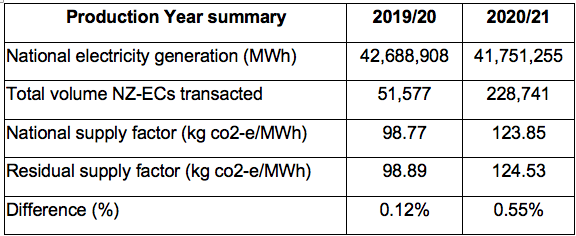Recently, we announced the completion of the 2020/21 Production Year. As a final step in the end of year process, we have now calculated the Residual Supply Mix (RSM) for the period from 1 April 2020 to 31 March 2021 for electricity certification.
Producing the RSM is a key function of our role as certification system operator. Doing so makes sure that the trade of certificates does not result in double-counting. We do this by:
- counting up all energy that was produced in New Zealand (the National Supply Mix)
- deducting the energy that was explicitly certified, and
- calculating the production characteristics of the remaining volume of energy (Residual Supply Mix.
The number produced describes the default characteristics of electricity supplied to users via the national grid, including emissions of Greenhouse Gases (GHGs), for the purposes of environmental reporting and carbon accounting.
Both the National Supply Mix (NSM) and Residual Supply Mix (RSM) change over time. The NSM is determined by how much of our electricity comes from renewable vs thermal generation. The RSM is determined by how many New Zealand Energy Certificates (NZ-ECs) have been traded – indicating the proportion of total renewable supply has been purchased explicitly.
Over time, we would expect that the NSM may become increasingly ‘renewable’ as we build more wind and solar generation and phase-out thermal generation. The RSM will move in the other direction – becoming more carbon intensive as more energy consumers make conscious purchasing decisions.
Not only does the RSM reduce the risk of double-counting, but it incentivises positive purchasing action among energy consumers, further supporting development of new renewable generation.
Want the detail?
In the 12 months to 31 March 2021, nearly 41.75 million MWh of electricity were generated in New Zealand. Total emissions from electricity generation were 5.2 million tonnes. Energy consumers bought 228,741 energy certificates from renewable energy generators, leaving the RSM at 41.52 million MWh.
This means that once certificates are accounted for, each MWh supplied to energy users who were not purchasing New Zealand Energy Certificates (NZ-ECs) carried with it (on average) almost 125kg of GHG emissions (carbon dioxide equivalent / CO2-e). For an average household, this works out to around 1 tonne of emissions released into the atmosphere in the generation of electricity used in your home over a year.
Detail of the National and Residual numbers for the 2020/21 year are included in the table below, shown against the previous year for comparison:

How is this changing?
Almost five times more certificates were bought in 2020/21 than in 2019/20. This is still a small percentage of total generation but will increase over time. As more energy users choose to purchase energy and NZ-ECs, the RSM will get increasingly more carbon-intensive.
The big change year-on-year was the difference in the underlying generation mix of New Zealand. The RSM in 2019/20 was 99kg CO2-e/MWh. In 2020/21 this increased by almost 30% to 125kg CO2-e/MWh. While the purchase of certificates contributed to the increase in carbon content of the RSM, the major driver was the reduced availability of renewable energy resources (hydro) throughout the course of the year.
This is because during 2020/21 conditions were very dry in both the North and South Islands with inflows dropping to approximately 90% of the historical average over the period. The drop off in hydro generation was made up by increased levels of thermal generation comprised of coal, gas and oil. Consequently, the proportion of renewable generation dropped from 83% during 2019/20 to 80% during 2020/21.
How should we use the Residual Supply Mix?
Use of the RSM is a key feature of GHG reporting, as recommended by leading corporate GHG reporting standards.
The main organisational reporting standards now recommend the use of ‘dual reporting’ in development of an organisations GHG inventory. Dual reporting looks at what is going on at a country level (termed location-based) and what an organisation is doing voluntarily through contractual instruments such as NZ-ECs (market-based).
Where an energy certificate market exists, the standards recommend an organisation report both NSM and RSM emission factors and perform optional offsetting on either in order to achieve carbon neutrality targets.
Certified Energy recommends use of the NSM as the location-based emissions factor, and either the Residual Supply Mix, or the specific emissions factor contained on your NZ-EC, as the market-based emissions factor.
What we are working on to make the RSM more useful
While a regular annual RSM is a useful tool to promote action and support renewable generation, we are continually looking for ways to increase the impact of the system. One method that we will trial is to report the RSM monthly to give a clearer picture of the seasonal differences in electricity generation, and more frequent updates on growth in renewable energy purchasing.
We have also considered a range of other improvements, such as specific supply factors for the different lines companies in New Zealand, or the ability to provide specific RSMs for each electricity supplier.
So watch this space, and if you have any questions, comments, concerns or suggestions, please do get in touch using the form below.